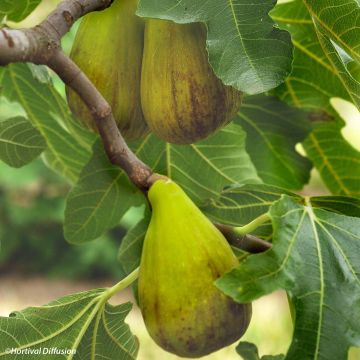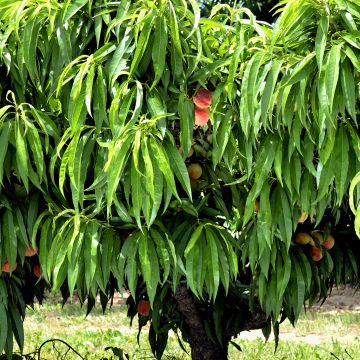

Olivier Cailletier (Olive de Nice) - Olea europaea
Olea europaea Cailletier - Olive tree
Olea europaea Cailletier
European Olive, Olive
Why not try an alternative variety in stock?
View all →This plant carries a 6 months recovery warranty
More information
We guarantee the quality of our plants for a full growing cycle, and will replace at our expense any plant that fails to recover under normal climatic and planting conditions.
Oversize package: home delivery by special carrier from €6.90 per order..
Express home delivery from €8.90.
Delivery to Corse prohibited: UE law prohibits the import of this plant from mainland France to Corse as part of the fight against Xylella fastidiosa. Please accept our sincere apologies.
More information
Description
The Cailletier olive is an ancient variety originating from the Alpes Maritimes. It is a vigorous variety with rapid and regular fruiting. It produces medium-sized, elongated ovoid olives with rounded tops and flavourful pulp, which turn from green to black when ripe. The Cailletier olive is self-fertile, not very resistant to cold temperatures (-8 to -10°C (17.6 to 14°F)) and quite susceptible to diseases. Harvesting takes place in November for green olives, and from December to March for black olives and oil. The later the harvest, the milder the oil. It is one of the best varieties for natural olives.
The expansion of the olive tree is linked to the establishment of the Mediterranean climate, which is the major constraint for its cultivation. The domestication of the olive tree is believed to have taken place six millennia ago. Olive trees can live to be very old. The oldest olive tree in the world is now 3000 years old. The Cailletier olive originates from the Alpes Maritimes. It is registered in the COV. It is the only authorised species in the AOP Olives de Nice.
The olive tree is a very branchy tree with gnarled trunks, hard and dense wood, and brown, cracked bark.
The elongated oval leaves are carried by a short, fairly hard petiole. They are entire and toothed on the edges, shiny dark green on the upper surface, and light green-silver with a prominent midrib on the lower surface. The foliage is evergreen and the leaves are constantly renewed.
The small white flowers are grouped in small clusters of 10 to 20 in the axils of the leaves, in April-May, on the previous year's wood. The Cailletier olive tree is self-fertile.
It produces medium-sized, elongated ovoid olives with rounded tops and flavourful pulp, which turn from green to black when ripe. The extracted oil is of very good quality.
Green olives are not consumed directly from the tree. They must first be prepared to remove any bitterness. There are many methods for preserving these table olives. They are all based on the same principle, in 3 steps. 1/ Remove the bitterness, either with a caustic soda bath, a quick solution or with ash lye, a more traditional and slower method. 2/ Rinse. 3/ Brining, with or without fermentation. For black olives, removing the bitterness is not necessary.
Table olives are consumed once prepared. They can also be used to produce olive oil.
Report an error about the product description
Olea europaea Cailletier - Olive tree in pictures




Plant habit
Fruit
Flowering
Foliage
Safety measures
Botanical data
Olea
europaea
Cailletier
Oleaceae
European Olive, Olive
Mediterranean
atteinterespiratoire
Cette plante peut entraîner des symptômes allergiques.
Evitez de la planter si vous ou vos proches souffrez de rhinite saisonnière ("rhume des foins").
Davantage d'informations sur https://plantes-risque.info
Other Olive trees
Planting and care
The Cailletier olive tree grows well in pots and open ground. In frost-prone regions, you can bring your olive trees in pots indoors from October to March (or longer depending on the freezing periods in your region) into a bright room. In open ground, if you are not in a Mediterranean region, protect your tree with fleece and mulch the base. In either case, choose a sunny location, in dry, rocky, or even poor, always well-drained soil. Limestone soils are not a problem, but olive trees dislike waterlogged soils.
Planting: Dig a hole at least twice the size of the pot. Keep the root ball intact. If a tight root ball has formed, spread it out when planting. Place the root ball in the hole. Secure the tree with stakes (if necessary, use two stakes. Protect the young tree from the wind). The tree should be staked until 5 years old. Fill the hole with soil, firming it down well. Create a mounded ring around the tree at 50 cm (20in) and pour 20 L of water in the middle, which will help the soil clingto the roots and promote successful planting. Leave 6 m (20ft) of distance in all directions between the trunks.
If you are growing in a pot, remember to repot your olive trees every approximately 3 years.
Planting period
Intended location
Care
This item has not been reviewed yet - be the first to leave a review about it.
Mediterranean fruit trees
Haven't found what you were looking for?
Hardiness is the lowest winter temperature a plant can endure without suffering serious damage or even dying. However, hardiness is affected by location (a sheltered area, such as a patio), protection (winter cover) and soil type (hardiness is improved by well-drained soil).

Photo Sharing Terms & Conditions
In order to encourage gardeners to interact and share their experiences, Promesse de fleurs offers various media enabling content to be uploaded onto its Site - in particular via the ‘Photo sharing’ module.
The User agrees to refrain from:
- Posting any content that is illegal, prejudicial, insulting, racist, inciteful to hatred, revisionist, contrary to public decency, that infringes on privacy or on the privacy rights of third parties, in particular the publicity rights of persons and goods, intellectual property rights, or the right to privacy.
- Submitting content on behalf of a third party;
- Impersonate the identity of a third party and/or publish any personal information about a third party;
In general, the User undertakes to refrain from any unethical behaviour.
All Content (in particular text, comments, files, images, photos, videos, creative works, etc.), which may be subject to property or intellectual property rights, image or other private rights, shall remain the property of the User, subject to the limited rights granted by the terms of the licence granted by Promesse de fleurs as stated below. Users are at liberty to publish or not to publish such Content on the Site, notably via the ‘Photo Sharing’ facility, and accept that this Content shall be made public and freely accessible, notably on the Internet.
Users further acknowledge, undertake to have ,and guarantee that they hold all necessary rights and permissions to publish such material on the Site, in particular with regard to the legislation in force pertaining to any privacy, property, intellectual property, image, or contractual rights, or rights of any other nature. By publishing such Content on the Site, Users acknowledge accepting full liability as publishers of the Content within the meaning of the law, and grant Promesse de fleurs, free of charge, an inclusive, worldwide licence for the said Content for the entire duration of its publication, including all reproduction, representation, up/downloading, displaying, performing, transmission, and storage rights.
Users also grant permission for their name to be linked to the Content and accept that this link may not always be made available.
By engaging in posting material, Users consent to their Content becoming automatically accessible on the Internet, in particular on other sites and/or blogs and/or web pages of the Promesse de fleurs site, including in particular social pages and the Promesse de fleurs catalogue.
Users may secure the removal of entrusted content free of charge by issuing a simple request via our contact form.
The flowering period indicated on our website applies to countries and regions located in USDA zone 8 (France, the United Kingdom, Ireland, the Netherlands, etc.)
It will vary according to where you live:
- In zones 9 to 10 (Italy, Spain, Greece, etc.), flowering will occur about 2 to 4 weeks earlier.
- In zones 6 to 7 (Germany, Poland, Slovenia, and lower mountainous regions), flowering will be delayed by 2 to 3 weeks.
- In zone 5 (Central Europe, Scandinavia), blooming will be delayed by 3 to 5 weeks.
In temperate climates, pruning of spring-flowering shrubs (forsythia, spireas, etc.) should be done just after flowering.
Pruning of summer-flowering shrubs (Indian Lilac, Perovskia, etc.) can be done in winter or spring.
In cold regions as well as with frost-sensitive plants, avoid pruning too early when severe frosts may still occur.
The planting period indicated on our website applies to countries and regions located in USDA zone 8 (France, United Kingdom, Ireland, Netherlands).
It will vary according to where you live:
- In Mediterranean zones (Marseille, Madrid, Milan, etc.), autumn and winter are the best planting periods.
- In continental zones (Strasbourg, Munich, Vienna, etc.), delay planting by 2 to 3 weeks in spring and bring it forward by 2 to 4 weeks in autumn.
- In mountainous regions (the Alps, Pyrenees, Carpathians, etc.), it is best to plant in late spring (May-June) or late summer (August-September).
The harvesting period indicated on our website applies to countries and regions in USDA zone 8 (France, England, Ireland, the Netherlands).
In colder areas (Scandinavia, Poland, Austria...) fruit and vegetable harvests are likely to be delayed by 3-4 weeks.
In warmer areas (Italy, Spain, Greece, etc.), harvesting will probably take place earlier, depending on weather conditions.
The sowing periods indicated on our website apply to countries and regions within USDA Zone 8 (France, UK, Ireland, Netherlands).
In colder areas (Scandinavia, Poland, Austria...), delay any outdoor sowing by 3-4 weeks, or sow under glass.
In warmer climes (Italy, Spain, Greece, etc.), bring outdoor sowing forward by a few weeks.

















































